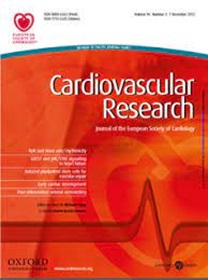Iron regulatory proteins secure iron availability in skeletal muscle to preserve exercise tolerance in heart failure.
IF 13.3
1区 医学
Q1 CARDIAC & CARDIOVASCULAR SYSTEMS
引用次数: 0
Abstract
AIMS Iron deficiency (ID) is a frequent comorbidity in heart failure (HF) and contributes to exercise intolerance. Tissue iron levels are maintained by cellular iron uptake, sequestration, and release, processes that are tightly controlled by iron regulatory proteins (IRP). Our aim was to explore the role of IRP activity in skeletal muscle function and exercise capacity during HF. METHODS AND RESULTS We observed that skeletal muscle ID is associated with IRP1 and 2 inactivation 12 weeks after transverse aortic constriction (TAC) in mice with left ventricular (LV) dysfunction and cachexia. To understand the functional implications of IRP inactivation in skeletal muscle, we generated skeletal muscle-specific Irp1/2 knock-out mice (SkM-Irp1/2-KO). These mice developed muscle ID, along with lower transferrin receptor 1 (TFR1) levels and decreased non-haem iron content, within 5 weeks after birth. SkM-Irp1/2-KO mice exhibited shorter running distances and slower velocities during treadmill exercise. Transcriptomic analysis revealed upregulation of gene clusters associated with endoplasmic reticulum stress, atrophy, mitochondrial dysfunction, and inflammation. Moreover, enhanced glycolysis, increased 18F-deoxyglucose uptake in quadriceps, and faster plasma glucose clearance were detected in SkM-Irp1/2-KO versus control mice. In contrast, SkM-Irp1/2-KO mice had markedly reduced complex I and II expression, a change that confirmed defects in oxidative phosphorylation. CONCLUSIONS HF leads to IRP1/2 inactivation, ID, and metabolic dysfunction in skeletal muscle in mice. IRP1/2 inactivation in skeletal muscle causes ID, impairs oxidative energy production, and promotes exercise intolerance by reducing the capacity for effective energy utilisation.铁调节蛋白确保骨骼肌中的铁可用性,以保持心力衰竭时的运动耐受性。
AIMSIron缺乏症(ID)是心力衰竭(HF)的常见合并症,并导致运动不耐受。组织铁水平是通过细胞铁的摄取、隔离和释放来维持的,这些过程是由铁调节蛋白(IRP)严格控制的。我们的目的是探讨IRP活性在心衰期间骨骼肌功能和运动能力中的作用。方法和结果我们观察到,在左心室功能障碍和恶病质小鼠横主动脉缩窄(TAC)后12周,骨骼肌ID与IRP1和2失活相关。为了了解IRP失活对骨骼肌的功能影响,我们产生了骨骼肌特异性Irp1/2敲除小鼠(SkM-Irp1/2-KO)。这些小鼠在出生后5周内出现肌肉ID、低转铁蛋白受体1 (TFR1)水平和低非血红素铁含量。SkM-Irp1/2-KO小鼠在跑步机上运动时表现出较短的跑步距离和较慢的速度。转录组学分析显示与内质网应激、萎缩、线粒体功能障碍和炎症相关的基因簇上调。此外,SkM-Irp1/2-KO小鼠与对照小鼠相比,糖酵解增强,股四头肌18f -脱氧葡萄糖摄取增加,血浆葡萄糖清除更快。相比之下,SkM-Irp1/2-KO小鼠的复合物I和II表达明显降低,这一变化证实了氧化磷酸化的缺陷。结论shf导致小鼠骨骼肌IRP1/2失活、ID和代谢功能障碍。骨骼肌IRP1/2失活会导致ID,损害氧化能量的产生,并通过降低有效能量利用的能力来促进运动不耐受。
本文章由计算机程序翻译,如有差异,请以英文原文为准。
求助全文
约1分钟内获得全文
求助全文
来源期刊

Cardiovascular Research
医学-心血管系统
CiteScore
21.50
自引率
3.70%
发文量
547
审稿时长
1 months
期刊介绍:
Cardiovascular Research
Journal Overview:
International journal of the European Society of Cardiology
Focuses on basic and translational research in cardiology and cardiovascular biology
Aims to enhance insight into cardiovascular disease mechanisms and innovation prospects
Submission Criteria:
Welcomes papers covering molecular, sub-cellular, cellular, organ, and organism levels
Accepts clinical proof-of-concept and translational studies
Manuscripts expected to provide significant contribution to cardiovascular biology and diseases
 求助内容:
求助内容: 应助结果提醒方式:
应助结果提醒方式:


